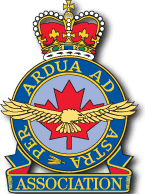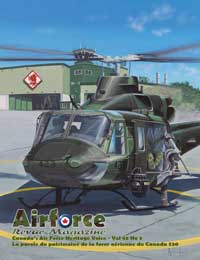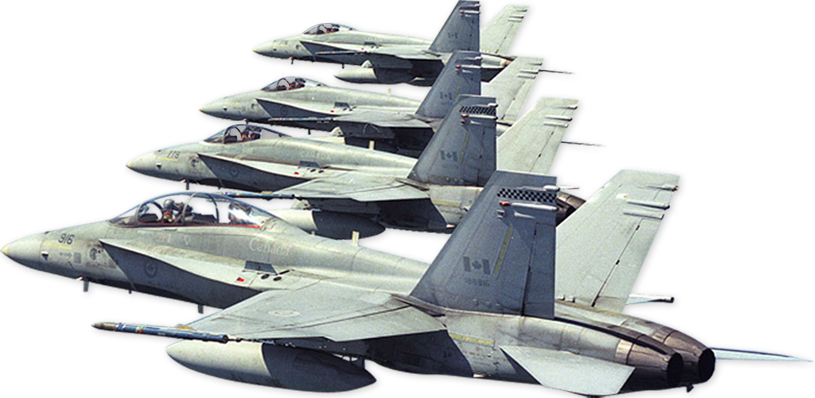Air Observation Post Squadrons
Late in 1944, three Air Observation Post (AOP) squadrons were formed overseas. Although the Auster aircraft were flown by members of the Royal Canadian Artillery (RCA) on spotting and ranging artillery fire, the squadrons were administered and serviced by the RCAF.
The first thought of forming Canadian AOP squadrons occurred in September 1941 when three RCA officers, Captains D.R. Ely, R.R. MacNeil and R.A. Donald, were sent on a nine-month AOP training course. After completing the course, the Canadian military authorities decided against the formation of Canadian AOP squadrons and the three trained officers were loaned to the British to fill vacancies in squadrons being formed in England. Three months before the entry of Canadian troops in the Mediterranean theatre, the three officers were withdrawn from the British squadrons and posted to the 1st Field Regiment, Royal Canadian Horse Artillery. During the attack on Ortona, in December 1943, Captain Donald was killed and Captain MacNeil captured.
As the Italian campaign continued, it became obvious to senior Canadian Army officers that AOP squadrons were a necessary part of a modem army and, in June 1944, the commander of the First Canadian Army recommended, and the War Cabinet authorized, the formation of Nos. 1, 2 and 3 Canadian AOP Squadrons RCA. Major Ely was given the responsibility of organizing these units. In September 1944 it was decided to follow British precedent in the command and control of AOP squadrons. On the recommendation of the army commander, the War Cabinet re-authorized the three units as squadrons of the RCAF – Nos. 664, 665 and 666 (AOP) Squadrons – the pilots to be drawn from the artillery. The squadrons were formed under RAF Fighter Command’s No. 70 Group and trained at No. 43 Operational Training Unit to observe artillery fire from the air and co-ordinate correction orders by the maneuvering of the aircraft. As the squadrons were declared operational, they were sent to the Continent and placed under the operational control of the First Canadian Army. Soon after the end of hostilities in May 1945, these squadrons ceased to be highly specialized units and were reduced to the level of a hire-taxi service until disbanded one by one, between July 1945 and June 1946.
No. 664 Squadron
Brief Chronology: Formed at Andover, Hants., Eng. 9 Dec 44. Disbanded at Apeldoom, Neth. 1 Jun 46.
Commanders
- Maj D.R. Ely 16 Dec 44 – 21 Jan 45.
- Maj D. W. Blyth 22 Jan 45 – 1 Jun 46.
Higher Formations and Squadron Locations
Fighter Command:
No. 70 Group,
No. 43 Operational Training Unit,
- Andover, Hants. 9 Dec 44 – 1 Feb 45.
- Penshurst, Kent 2 Feb 45 – 21 Mar 45.
First Canadian Army:
- Tilburg, Neth. 23 Mar 45 – 31 Mar 45.
- Breda, Neth. 1 Apr 45 – 21 Apr 45.
- Meppen, Ger. 22 Apr 45 – 5 May 45.
- Rostrup, Ger. 6 May 45 – 16 Jun 45.
- Apeldoom, Neth. 17 Jun 45 – 1 Jun 46.
Representative Aircraft
Auster A.O.P.Mk.IV & V (Jan 45 – May 46)
- MS945 MS946 MT166 TJ418
Operational History: First Mission 29 March 1945, Auster V RT564 with Capt G.M. Henderson and LAC R.S. Laye – reconnaissance of the Maas-Heusden area.
Last Mission: 5 May 1945, Auster V RT515 with Capt D.G. Rouse and LAC M.L. Wright – reconnaissance of a new air landing ground.
Summary Sorties: 619.
- Operational/Non-operational Flying Hours: 583/4362.
- Casualties:
- Operational: 1 aircraft; 2 killed.
- Non-operational: nil.
No. 665 Squadron
Brief Chronology: Formed at Andover, Hants., Eng. 22 Jan 45. Disbanded at Apeldoorn, Neth. 20 Jul 45.
Commanders
- Maj D.R. Ely 22 Jan 45 – 4 Mar 45.
- Maj N.W. Reilander 5 Mar 45 – 12 Jun 45.
- Capt W.K. Buchanan 13 Jun 45 – 10 Jul 45.
Higher Formations and Squadron Locations
Fighter Command:
No. 70 Group,
No. 43 Operational Training Unit,
- Andover, Hants. 22 Jan 45 – 16 Mar 45.
- Oatlands Hill, Wilts. 17 Mar 45 – 18 Apr 45.
First Canadian Army:
- B.77 Gilze-Rijen, Neth. 21 Apr 45 – 26 May 45.
- Borne, Neth. 27 May 45 – 6 Jun 45.
- Apeldoom, Neth. 7 Jun 45 – 10 Jul 45.
Representative Aircraft
Auster A.O.P.Mk.lV & V (Feb – Jul 45)
- TJ346 TJ366 TJ402 TJ484
Operational History: First Mission 27 April 1945, Auster V TJ342 with Capt B.R.H. Watch – shoot on enemy gun positions on Duiveland Island.
Last Mission: 7 May 1945, Auster V TJ399 with Capt W. G. Milliken – reconnaissance.
Summary Sorties: 58.
- Operational/Non-operational Flying Hours: 24/2092.
- Casualties:
- Operational: nil.
- Nonoperational: 3 aircraft; 1 pilot killed, 3 injured (2 in nonflying accidents).
No. 666 Squadron
Brief Chronology: Formed at Andover, Hants., Eng. 5 Mar 45. Disbanded at Apeldoorn, Neth. 1 Nov 45.
Commanders
- Maj D.R. Ely 5 Mar 45 – 11 Jun 45.
- Maj A.B. Stewart 12 Jun 45 – 1 Nov 45.
Higher Formations and Squadron Locations
Fighter Command:
No. 70 Group,
No. 43 Operational Training Unit,
- Andover, Hants. 5 Mar 45 – 17 Apr 45.
- Friston, Sussex 18 Apr 45 – 26 May 45.
First Canadian Army:
- B.77 Gilze-Rijen, Neth. 28 May 45 – 5 Jun 45.
- Hilversum, Neth. 6 Jun 45 – 24 Jun 45.
- Apeldoom, Neth. 25 Jun 45 – 1 Nov 45.
Representative Aircraft
Auster A.O.P. Mk.IV & V (Mar – Oct 45)
Operational History: Never employed on operations.
- Flying Hours: 3728.
- Casualties: nil.








